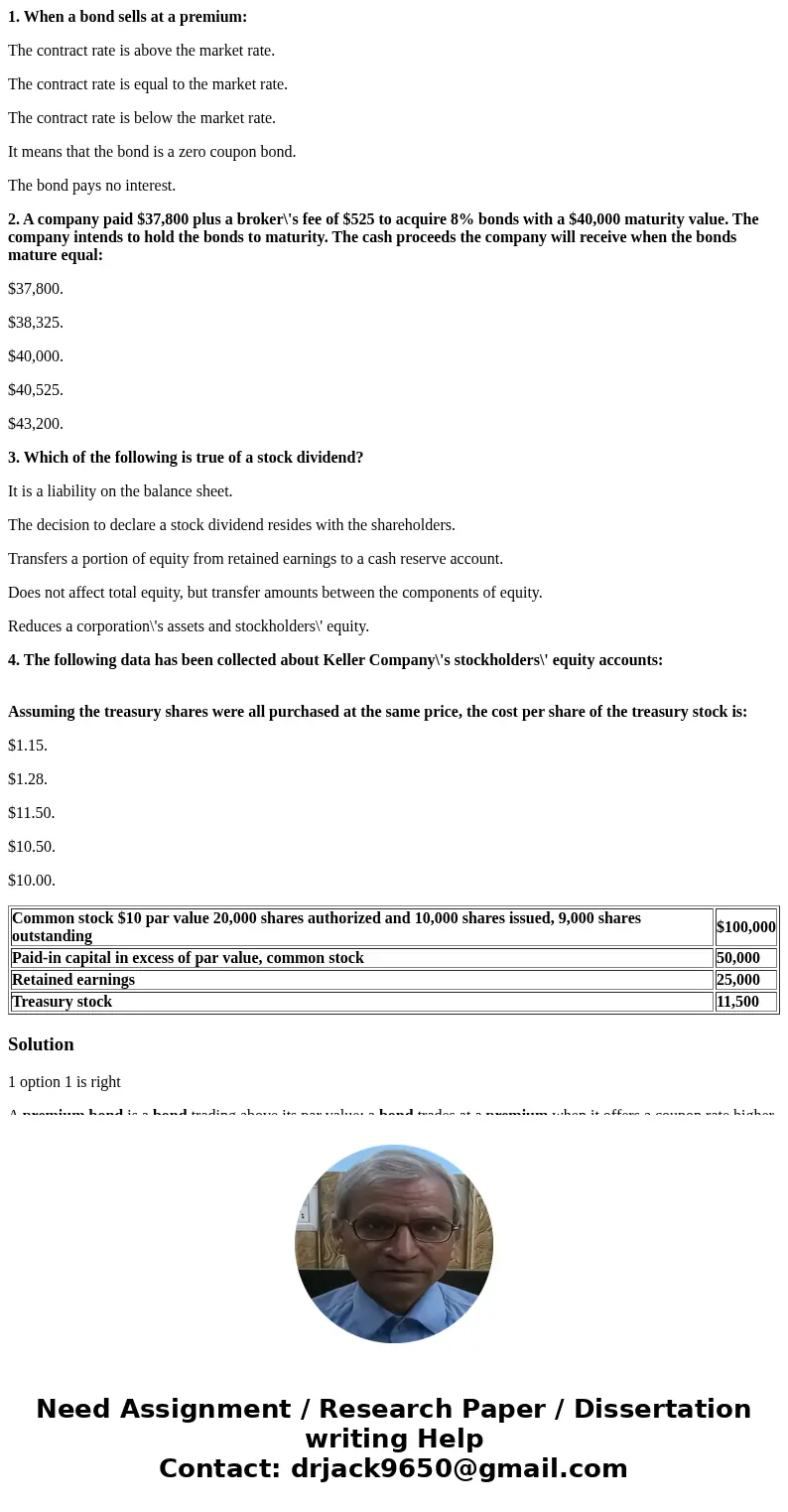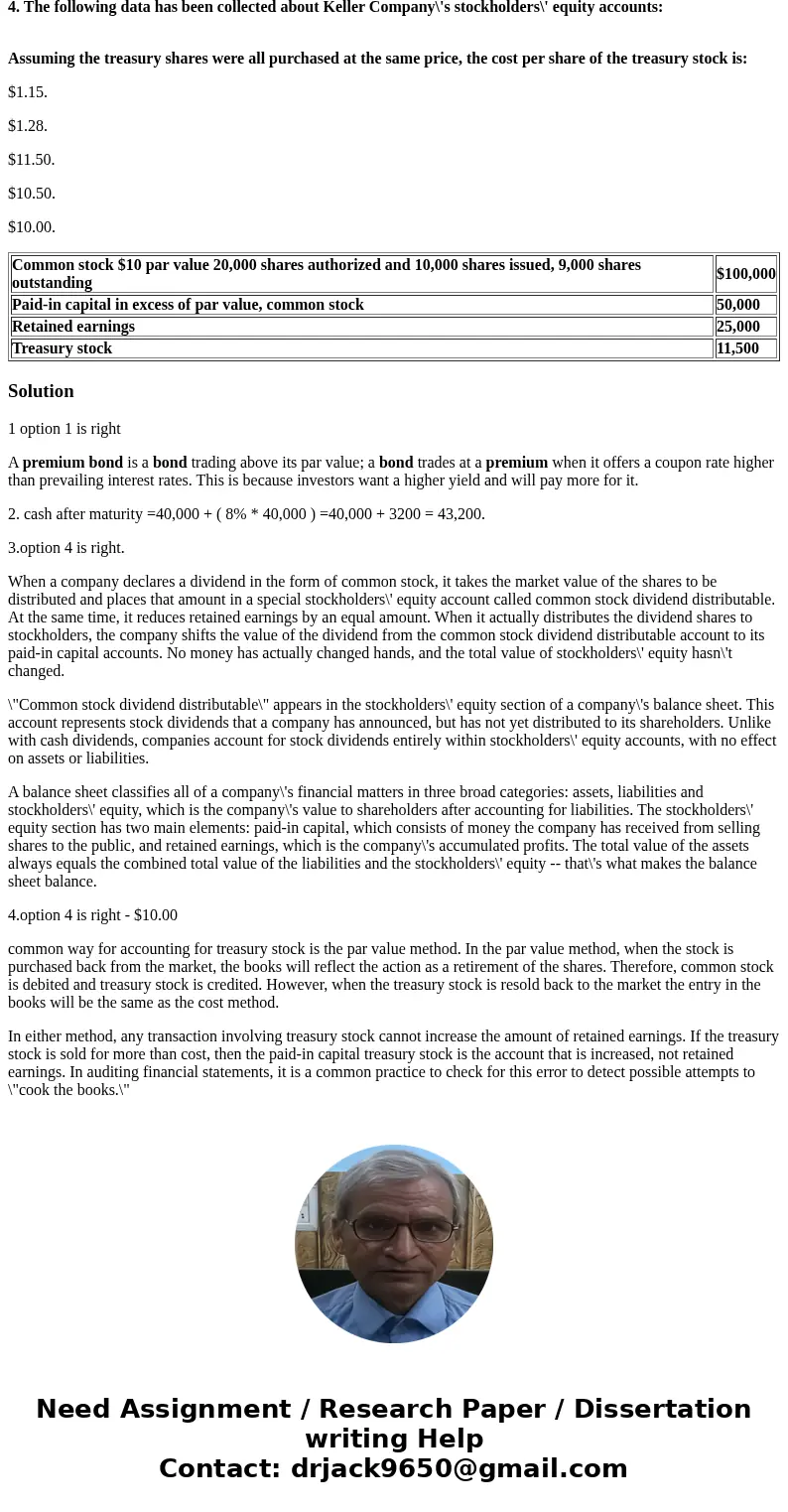1 When a bond sells at a premium The contract rate is above
1. When a bond sells at a premium:
The contract rate is above the market rate.
The contract rate is equal to the market rate.
The contract rate is below the market rate.
It means that the bond is a zero coupon bond.
The bond pays no interest.
2. A company paid $37,800 plus a broker\'s fee of $525 to acquire 8% bonds with a $40,000 maturity value. The company intends to hold the bonds to maturity. The cash proceeds the company will receive when the bonds mature equal:
$37,800.
$38,325.
$40,000.
$40,525.
$43,200.
3. Which of the following is true of a stock dividend?
It is a liability on the balance sheet.
The decision to declare a stock dividend resides with the shareholders.
Transfers a portion of equity from retained earnings to a cash reserve account.
Does not affect total equity, but transfer amounts between the components of equity.
Reduces a corporation\'s assets and stockholders\' equity.
4. The following data has been collected about Keller Company\'s stockholders\' equity accounts:
Assuming the treasury shares were all purchased at the same price, the cost per share of the treasury stock is:
$1.15.
$1.28.
$11.50.
$10.50.
$10.00.
| Common stock $10 par value 20,000 shares authorized and 10,000 shares issued, 9,000 shares outstanding | $100,000 |
| Paid-in capital in excess of par value, common stock | 50,000 |
| Retained earnings | 25,000 |
| Treasury stock | 11,500 |
Solution
1 option 1 is right
A premium bond is a bond trading above its par value; a bond trades at a premium when it offers a coupon rate higher than prevailing interest rates. This is because investors want a higher yield and will pay more for it.
2. cash after maturity =40,000 + ( 8% * 40,000 ) =40,000 + 3200 = 43,200.
3.option 4 is right.
When a company declares a dividend in the form of common stock, it takes the market value of the shares to be distributed and places that amount in a special stockholders\' equity account called common stock dividend distributable. At the same time, it reduces retained earnings by an equal amount. When it actually distributes the dividend shares to stockholders, the company shifts the value of the dividend from the common stock dividend distributable account to its paid-in capital accounts. No money has actually changed hands, and the total value of stockholders\' equity hasn\'t changed.
\"Common stock dividend distributable\" appears in the stockholders\' equity section of a company\'s balance sheet. This account represents stock dividends that a company has announced, but has not yet distributed to its shareholders. Unlike with cash dividends, companies account for stock dividends entirely within stockholders\' equity accounts, with no effect on assets or liabilities.
A balance sheet classifies all of a company\'s financial matters in three broad categories: assets, liabilities and stockholders\' equity, which is the company\'s value to shareholders after accounting for liabilities. The stockholders\' equity section has two main elements: paid-in capital, which consists of money the company has received from selling shares to the public, and retained earnings, which is the company\'s accumulated profits. The total value of the assets always equals the combined total value of the liabilities and the stockholders\' equity -- that\'s what makes the balance sheet balance.
4.option 4 is right - $10.00
common way for accounting for treasury stock is the par value method. In the par value method, when the stock is purchased back from the market, the books will reflect the action as a retirement of the shares. Therefore, common stock is debited and treasury stock is credited. However, when the treasury stock is resold back to the market the entry in the books will be the same as the cost method.
In either method, any transaction involving treasury stock cannot increase the amount of retained earnings. If the treasury stock is sold for more than cost, then the paid-in capital treasury stock is the account that is increased, not retained earnings. In auditing financial statements, it is a common practice to check for this error to detect possible attempts to \"cook the books.\"


 Homework Sourse
Homework Sourse